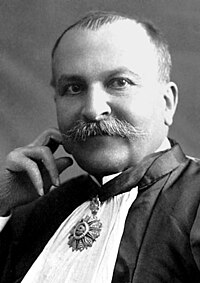
Photo from wikipedia
Improving transition metal-nitrogen-carbon (M-N-C) as a noble-metal-free catalyst for the oxygen reduction reaction (ORR) is critical to achieve low-cost electrochemical energy conversion. Herein, an in situ S doping strategy of… Click to show full abstract
Improving transition metal-nitrogen-carbon (M-N-C) as a noble-metal-free catalyst for the oxygen reduction reaction (ORR) is critical to achieve low-cost electrochemical energy conversion. Herein, an in situ S doping strategy of enhancing Fe-N-C activity for ORR was developed by newly designed Fe(II) ion coordinated S-containing bis(imino)-pyridine-based polymers as precursors, which were synthesized through copolymerizing three monomers of 2, 6-diacetylpyridine (DAP), triamterene (TIT), and 2,5-dithiobiurea (DTB) as both N and S sources. All samples derived from various molar ratios of the three monomers possess a self-supporting structure of nanosheets. Additionally, incorporating DTB into the copolymer can not only strongly affect the derived coordinative species of N dopants to Fe atom but also effectively induce the synergistic effect between S dopants and FeNx moieties, resulting a significant improvement for ORR. The S-doped Fe-N-C nansheets with Fe coordinated by 4 pyrrolic N dopants exhibit the highest ORR activity and stability in alkaline media with a higher power output of Zn-air battery than that of the same loading of Pt/C. Theoretical calculation identifies that the thiophenic S dopant adjacent to Fe-pyrrolic N moiety can decrease the d band center of Fe atom, greatly weakening the energy profiles of oxygenated intermediates and thus enhancing ORR. In addition, because of the designability of transition metal coordinated S-containing bis(imino)-pyridine based polymers in the work, therefore, it is believable that this strategy would open a wide space to explore the structural relationship between precursors and MNx active sites with S dopants for the purpose of achieving highly efficient and robust M-N-C catalysts for energy-related electrocatalysis.
Journal Title: ACS applied materials & interfaces
Year Published: 2022
Link to full text (if available)
Share on Social Media: Sign Up to like & get
recommendations!